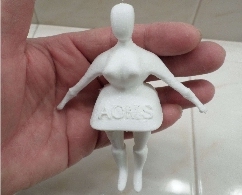3D Printing Software and Apps
Besides foot orthotics CNC milling, we offer 3D printing PC software and iOS apps, which can produce foot orthotics. There are three flavors you can choose from.
1. We have the AOMS 3DPRN app running on iPad or iPhone. You can get all kinds of orthotic types, like clips, flanges, Ray Cutouts, Cobra, etc. However, it is not a fully customized orthotic. You can partially customize the orthotics, like the width, length, height. However, the orthotic is more customized than OTC orthotics.
2. We have the AOMS 3DPRN software running on PC computers. You can fully customize the orthotic shells. This software cannot read your previous corrections made for AOMS mold or orthotic systems though. The orthotic types are not as many as in the AOMS 3DPRN app. You can have heel post.
3. Our new AOMS TOT CNC software running on a PC computer can produce fully customized orthotic shells, as a bonus. However, you need to add post manually. The software is mainly for CNC milling.
Previous R&Ds:
Sharp Shape provides new technologies in the field of foot orthotic manufacturing and production. Located in the Silicon Valley, Sharp Shape always innovates. Do you need 3D-printed foot orthotics or CNC milled orthotics? You name it and we have them. When we say 'CNC milled orthotics', we mean one of the following:
1. Milled positive mold and orthotic is made through regular thermo-forming method.
2. Directly milled orthotic shell.
3. Milled EVA insole.
We made some progress on the 3D-printer front. A business partner made this real-size orthotic (shown below) with his 3D printer. The material is ABS. The texture feels very nice. It is very clean and it looks like there are no supporting materials left. The only weakness remaining is the time. Although shortened, it still takes a little too long to make one. We are still making and waiting for a break-through. Click on one of the following two images to view the enlarged image.
Some customers asked us about our readiness in 3D printing. We have followed the technology for more than 10 years and we have been developing software for custom 3D printed foot orthotics and insoles for many years. Right now, 3D printers made headlines and we took a closer look at the current technology. Further, we bought a 3D printer for R&D. Our concentration is on the 3D printer in the orthotic manufacturing field. Some findings are shown below and we want to share them with you.
Note: I am able to hold the AOMS lady in my hand for the first time, thanks to the 3D printer.
Pros
• Quick turnaround for prototyping. No longer need a heavy CNC mill/router to make prototype models.
• Making parts that cannot be made with a CNC mill/router, for example, making a ball with a hollow inside.
• Small footprint. Suitable for small spaces.
• Less expensive now.
• More environmentally friendly compared to a CNC mill/router.
Cons
• Slower speed for production, compared to a CNC mill/router. 4 to 5 hours for a single orthotic.
• Smaller build-area compared with the carving envelope of a CNC mill/router.
• Materials are very limited in options. PLA is most common. ABS is an option.
These pros and cons are changing with the improvements in technology. For example, the cost of the 3D printer is less expensive. $2,000 is a typical price. A CNC router costs $20,000. If we buy ten 3D printers and use them simultaneously, we may overcome the slow-speed disadvantage.
For orthotic production, two major concerns have not been resolved. First is the production speed and second is the choice in materials.
The traditional CNC manufacturing process used on a mill, lathe etc. is to remove (subtract) material from a material block, while the new CNC manufacturing process used on a 3D printer is to build (add) material on a platform. From this point of view, the new manufacturing process is revolutionary.
Side notes: sometimes 3D printing ended with errors (SD cannot be read or file error). A few times, the builds ended with mess-ups. It is hard to decide to use "supports" (the material underneath) or not. It is hard to clean these supports.
Our conclusions: it is a little too early to use the 3D printer in the orthotic productions now, because of the above mentioned facts. CNC mills and routers are still widely used in orthotic labs now. This may change along with time.
Here are some videos and photos:
Click Play to see video. Need speakers for sound.




If you need anything, Contact Us.




